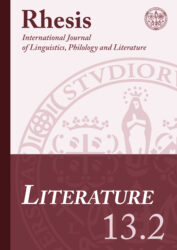 Linguistics and Philology
Linguistics and PhilologyVol. 13.1 - December 31, 2022
Download issue
Table of contents
| p. 5 | Proust und Wagner: Spielformen der Wagner-Rezeption im Werk von Marcel ProustUta FeltenAbstract The various ways in which Wagner is received in Marcel Proust’s work range from ironic-parodic reminiscences in the prose text «Mondanité et Mélomanie de Bouvard et Pécuchet» to complex appropriations of Wagnerian leitmotif technique and its functionalization as a filter of autoerotic love construction in «Mélancolique villégiature de Madame de Breyves».
The paper focuses on the significance of Wagner’s music as générateur of a musical mode of writing and as mediator within a triangular structure of desire.
|
| p. 13 | Su due recitazioni tritonali dello śloka sanscritoPaolo MiliziaAbstract In contemporary India many recitation practices of Classical Sanskrit metrical texts are observed. The present paper will focus on two particular chanting styles applied to the Classical Sanskrit śloka and based on tritonal scales and will try to show that the relationship existing between these two styles can be described as a “modal transposition” and is parallel to that existing between the Tamil and the Nambudiri styles of Veda recitation. These observations allow us to highlight that, in order to analyse the chanting practices belonging to Old Indo-Aryan texts, one has to distinguish at least three different levels: the scale (that is the inventory of tones), the melodic profile described prescinding without considering the scale (or, more precisely, without considering the intervals between the grades of the scale), the rhythmic profile.
|
| p. 27 | Il racconto della talassemia: Nelle mie vene e Paura di guarireRamona OnnisAbstract This study aims to analyse the narrative of thalassemia in two contemporary texts: Paura di guarire, by Ivano Argiolas (2021) and Nelle mie vene, by Flavio Soriga (2019). In the wake of the strand of narrative medicine studies, the intent is to investigate how the experience of illness and the resulting path and relationship of care are narrated.
|
| p. 37 | Vom Verb zum Nomen Dion. Hal. Amm. II 5Alessandra PallaAbstract The paper proposes a new reading and interpretation of one of the most discussed passage from Dionysius of Halicarnassus’ Epistula ad Ammaeum II (5).
|
| p. 49 | Dioscorides and his “mythological epigrams”: the rediscovery of a hitherto neglected poetVeronica PiccirilloAbstract Unlike other Hellenistic poets, Dioscorides (3rd c. BCE) has been rather neglected by the scholars throughout the centuries. His remaining epigrams are traditionally divided into five thematic areas: erotic, funerary, dedicatory, descriptive, and satirical. However, through an in-depth analysis of his production, it is possible to identify new different topics. In some compositions, indeed, the poet tends to draw attention towards several mythical events: in AP 5.138, the well-known topos of the flamma amoris becomes the most convenient metaphor to depict the Trojan fire; while in AP 12.37, Dioscorides presents a comparison between the handsome Sosarchos and Ganymede, Zeus’ mythical cupbearer. Nevertheless, his interests focus on the etiological nature of these legends as well: in AP 9.340, indeed, he takes a precise position within the mythological tradition describing the invention of the aulos; in AP 6.220, instead, he retraces the origins of the Great Mother Cybele’s rituals; and in AP 7.407, he eventually contributes to the birth of a brand-new goddess: Sappho the tenth Muse.
|
| p. 64 | Sulla tradizione dell’Halieuticon Liber attribuito ad OvidioFrancesco TestaAbstract This contribution provides a brief description of the handwritten tradition of Halieuticon book ascribed to Ovid. Through the analysis of some phenomena concerning lessons, the errores diuisionis and the text distribution in the graphic mirror, especially in case of lacunae, it is tried to demonstrate the independence of the Parisinus Lat. Thuaneus 8071 (B) from the Vindobonensis 277 (A). Through a lesson in v. 44, it is hypothesised a contamination made by the copyist of B from A.
|
Tags: Alessandra Palla, Care, Chanting, commentary, Contemporary Indian culture, cultura indiana contemporanea, cura, Dionysios von Halikarnass, Dionysius of Halicarnassus, Dioscorides, Epigrams, Epistula ad Ammaeum II, Francesco Testa, Halieuticon, handwritten tradition, Hellenistic Age, Intermedialität, intermediality, medicina narrativa, Memoir, Metre, metrica, Music, musica, Mythology, Narrative Medicine, Ovid, Ovidio, Paolo Milizia, Parodie, parody, Plemmyrion, Proust, Ramona Onnis, recitazione, relationship, relazione, sanscrito, Sanskrit, śloka, talassemia, Thalassemia, tradizione manoscritta, triangular desire;, trianguläres Begehren, Uta Felten, Veronica Piccirillo, Wagner
 Linguistics and PhilologyVol. 13.1 - December 31, 2022
Linguistics and PhilologyVol. 13.1 - December 31, 2022